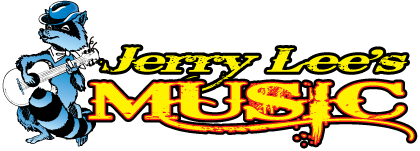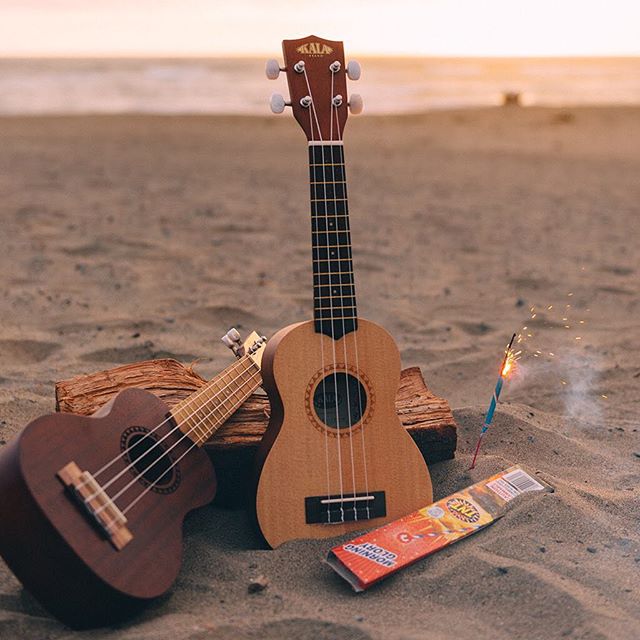No products in the cart.
The ukulele is not an ancient instrument yet after its initial ups and down as the guitar’s little sister, we are now experiencing an incredible recent ukulele revival. As a hybrid descendant of the historic guitar line, it started its ascent in popularity with sugar cane field workers from the Atlantic Portuguese island of Madeira landing in Pacific Hawaii in 1879. Many of the first 400 immigrants became infatuated with the island and its diverse, cosmopolitan atmosphere and stayed after their contracts had ended.
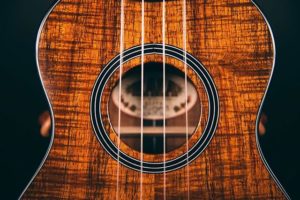 While not a direct descendant of any particular string instrument; the uke is a hybrid, with the father being the most likely the Portuguese machete de braga for size and the five-string rajão, for tuning and sound. All these instruments are part of a family of small guitar-like instruments dating from the 18th century. The Machete or Portuguese ‘braguinha’ (a nickname for the Portuguese instrument also known as the cavaquinho), is a small four-stringed Madeiran guitar.
While not a direct descendant of any particular string instrument; the uke is a hybrid, with the father being the most likely the Portuguese machete de braga for size and the five-string rajão, for tuning and sound. All these instruments are part of a family of small guitar-like instruments dating from the 18th century. The Machete or Portuguese ‘braguinha’ (a nickname for the Portuguese instrument also known as the cavaquinho), is a small four-stringed Madeiran guitar.
The four godfathers of the ukulele are Manuel Nunes, Joao Fernandes, Augusto Dias and Jose do Espirito Santo, who all arrived from Madeira in Hawaii on the German vessel ‘Ravenscrag’ in 1879, along with 400-plus other immigrants.
Fernandes allegedly surprised and delighted Honolulu’s dockside natives by playing tunes on a small stringed instrument. Because these little instruments were often carried by farm workers to the taro fields, they became known as ‘taro patch fiddles’ and pila li’ili’i – little fiddles.
Nuñes, Dias and Santo were also cabinet makers, with a sideline of instrument making. Once their contract ended and they left the sugar cane fields, they quickly started making versions of their native instruments for themselves and their friends – identified on contemporary ads for their shops as machetes.
Dias opened a small shop making and repairing musical instruments in 1884. Santos and Nuñes opened their shops in 1888.
Nuñes and his sons later opened a ukulele production factory in 1910; although Nuñes died in 1922, the company was still making ukuleles in the 1930s, after all the others closed. His son, Leonardo, took over at the end. Although Nuñes would later claim to have invented the ukulele, that claim has since been challenged without denying him his important role in its early development, however.
The little instrument became an almost instant hit among the native Hawaiians. Even the royal family of Hawaii, including popular Princess Victoria Kaiulani took to playing it. In part because of their patronage and also the use of native woods and materials, Hawaiians took to it and soon developed their own musical style and sound around it, originally adopting the uke’s tuning from the rajão (pronounced rah-ZHOW), the 5 string Madeiran instrument, that featured an open-G tuning.( When and why it was changed to my-dog-has-fleas is one of those little mysteries that always leads to more questions than answers). In the early 1890s, a fellow named Holstein, who headed up the music department of the Hawaiian News Co., published a pamphlet entitled Chords of the Taro-patch Guitar, which is what Honoluluans called the rajão in those days. Holstein, an astute businessman, also included directions for tuning the “ukulele-guitar”. You tune it the same as you tune the top four strings of the taro-patch,” he said, and printed entire music catalogs.
• G: the 4th string
• C: the 3rd string
• E: the 2nd string
• A: the 1st string
Another popular tuning is called the D6 tuning which is A/D/F#/B. The uke has many cousins in the musical world. Aside from the ancestral guitar, the family includes the aforementioned braguinha, cavaquinho and rajão, and also the charango, timple, tiple and Venezuelan cuatro, as well as the tenor or parlor guitar and the more recent “guitarlele” or U-tar.
Ukuleles were first shown on the mainland US in 1893, at the World’s Columbian Exposition, in Chicago, but they didn’t develop much interest. However, the performance of Hawaiian music helped cement the popular association between the ukulele and Hawaiian culture. The exhibition also appeared in San Francisco at the California Mid-Winter Fair, 1894. Other Hawaiian musicians took to the mainland vaudeville stage circuit, performing in Los Angeles, New York, Atlanta, Chicago, Buffalo and Atlantic City over the next decade.
The first printed reference to the word ukulele comes from the Hawaiian Gazette of 1895. KOA, a native Hawaiian tonewood, helped associate the uke with Hawaii and Hawaiian culture.
Of the original foursome, Espirito Santo was the first to advertise “ukuleles” in 1898. That same year Dias advertised his “instruments made of Hawaiian wood.” The abbreviation “uke” dates to 1891, from a travel book about Hawaii.
Corporate America Gets into the Game
In 1907, the Martin Company started making ukuleles for the mass markets, but without proper marketing it did not create a following, hence no demand and soon they stopped production. By 1910, the instrument was being sold by the Ditson Co. in New York City. The 1911 play, “The Bird of Paradise” featured an accompaniment of Hawaiian music.
In 1915 the ukulele was shown in a Hawaiian exhibition at the Panama-Pacific International Exposition in San Francisco and that seems to have launched the mainland craze. Ukulele-maker Dias died two weeks before that show opened and never witnessed its popularity. But from that show, the uke’s popularity began to soar.
After the fair, the Martin Company started up production again and in 1917 changed its design to cater to the growing craze for the instrument and their model took off. In 1920 they also moved to ukes made from Hawaiian KOA wood. In 1925 they made their first concert-scale uke. At its peak in 1926, Martin manufactured 14,000 ukuleles.
That same year, Sears Roebuck bought the Harmony guitar company to make ukuleles and cash in on the craze. Hawaiian music also became incredibly popular, as a result. Ukes were mass-produced in the thousands – Harmony sold 500,000 in 1931 alone.
Ukulele fever rapidly spread across the mainland, branching out to develop new sizes and designs. In the decade following its 1915 introduction, mainland companies like Martin, Regal, Harmony, Lyon and Healy, National, Dobro and Gibson had all started making models. They made ukes for themselves or as rebranded instruments for other companies. In reaction, Hawaiian makers created a distinctive trademark, protected by legislation, with authority to say “Made in Hawaii, U.S.A.” It was illegal to use the marker on any ukuleles not made in the Hawaiian Islands.
Today Vintage Martin ukes remain the most sought-after ukuleles among collectors (the 5K models being the most treasured). Around the turn of the 20th century, some manufacturers also started producing tenor or parlor guitars, which are like the progeny of a ukulele and a standard guitar. The small size, ease of play, friendly sound and low cost (compared to many other musical instruments) helped keep the uke popular and it soon spread across to Europe.
Four Sizes of Ukuleles
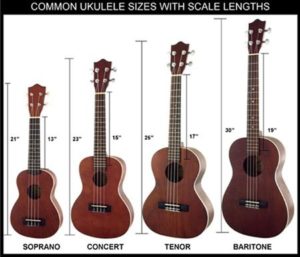
Officially their are 4 sizes of Ukuleles, – the Soprano, the Concert, the Tenor and the Baritone. Having said that, in 1917, a Hawaiian maker, Alvin D. Keech introduced his “banjulele-banjo”, which became known as the banjolele or banjo ukulele. Although Keech (who later moved to England) claimed to have invented the instrument, and who trademarked the name ‘banjulele’, there were earlier pioneers working on the same design. John A, Bolander of California filed a patent for a banjo ukulele design with a closed back resonator on June 25, 1917. He had been manufacturing his “Boldander’s Ukulele Banjo” at least since 1916.
This instrument was most popular in the 1920s and ’30s, and was commonly used in Vaudeville acts where its loud sound was more easily heard than the sound of the ukulele. British actor, comedian George Formby was one its most successful players.
Concert scale BUs seem to have been developed in the early-mid 1920s. Many of the early BU makers were banjo makers as well, but some, like Gibson, made a range of stringed instruments, while Slingerland also made drums.
Popularity that Floated on Romance
The Waikiki beach boys of the 1920s gave the uke a romantic, exotic mystique that suited the islands, but financial popularity came from the mainland where ukuleles sold literally millions in the pre-war decades. Small, easy to carry, fun to play and inexpensive – it became the most popular musical instrument in that pre-war period.
Tin Pan Alley and vaudeville both took up the uke in many acts and songs, and you can still find many song sheets and books from that era with ukulele chords shown. In an era with no or at best primitive amplification for stage shows, the banjo ukulele became popular for its greater volume.
For a while the uke quickly became the most popular musical instrument in the world. Even Edward, Prince of Wales played the ukulele in the mid-1920s. Harmony built a special, gold-engraved uke for Edward, with his coat-of-arms and seal embossed on it.
Uke fever even reached into Germany, where a 1924 newspaper story reported that uke sales in Germany were growing rapidly, and that the tax applied to these musical instruments was helping Germany pay down its war reparations debt.
Manuel Nuñes, the last of the original ukulele makers, died in 1922, still in Honolulu. In 1927, his one-time apprentice, Sam Kamaka, patented his pineapple uke, aimed at a fuller, richer sound than the Portuguese style.
The 1929 Depression and years after were hard on the ukulele. Competition from the mainland had already hurt local producers, and the Great Crash forced several Hawaiian manufacturers to close. John King notes that, by 1933, uke-maker Sam Kamaka estimated he was selling 15 ukuleles a month, down from three to four hundred a month in times before the Depression.
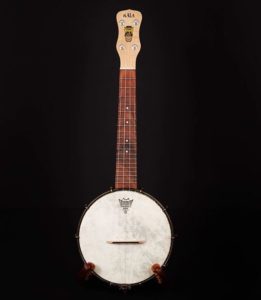
In addition by the mid-late 1930s, the guitar had started to muscle its way into the market and was taking over in terms of popularity. In part that was because the electric guitar (and its associated amplifying and recording technologies) had been improved enough that the guitar was increasingly able to be part of the bands and orchestras of the day, so it picked up momentum through popular music. Before that, unamplified guitar was lost in the sound and volume (the banjo was the popular stringed instrument in orchestras for its volume). Also the arrival of some talented jazz guitar players like Eddie Lang, Charlie Christian and Django Reinhardt helped make it an increasingly popular instrument.
The Lean Years After World War II
After WWII, the guitar rocketed in its ascendancy as the most popular instrument for the new sound – R&B, rock & roll, and pop. Ukes were on the way out, at least as a popular mainstream instrument. Although they would continue as a Hawaiian instrument, and there was a brief resurgence in the post-war years, they were not the popular instrument of the 1920s.
The uke went through another minor revival in popularity in the late 1940s when US servicemen returned from the Pacific war with ukuleles and Hawaiian music. But it was more a short-lived novelty spurt than a Renaissance.
A new threat to Hawaiian’s national instrument came when Maccaferri’s Mastro Plastics Corp. started making all-plastic ukuleles in the 1950s. The most popular was the Islander. Maccaferri, a guitar maker, became intrigued with making instruments out of plastic. He applied his instrument-making skill to produce the “TV Pal,” a plastic ukulele. By March, 1950, Mario Maccaferri was making 2,500 of his plastic ukuleles a day. More than nine million of these had sold by 1958. Sales were spurred by its low cost and a link with the popular television show “Arthur Godfrey and his Ukulele.”
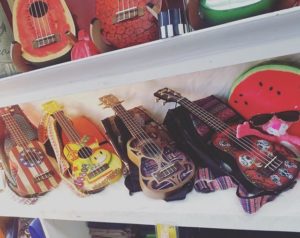
A mini-revival lasted through the 1950s and sputtered on through the 1960s. The changes in popular music in the 1950s and 60s saw the market give way to the guitar and other instruments, especially the electric variety. Aside from novelty acts like Tiny Tim and Martin Mull, and a few performances by George Harrison of The Beatles, almost no one played the uke commercially or professionally outside Hawaii in the 60s and 70s. Popularity eroded under the influence of the guitar.
Even though several companies continued to make or sell ukes in the 1960s, they slowly evaporated until few were still on the scene by 1970. By the 1970s, there was only one major manufacturer left – Kamaka, started by Sam, an apprentice of Nuñes.
The next 30 years were extremely tough for the instrument outside of the Hawaiian islands, until in the 1990s, the picture began to change. Thanks to the Internet, accomplished ukulele performers, manufacturers and aficionados were able to meet, communicate, and share music. That rapidly blossomed into a subculture, and today’s ukulele revival makes it once again one of the most popular musical instruments around. It’s popularity keeps growing rapidly, with one of the largest and most active online communities.
Incredibly Talented Performers
Performers like Jake Shimabukuro, Dr. Mike Okouchi and the incredible Honolulu born and raised Taimane Gardner have been able to find a new and appreciative audience. These and other brilliant ukulele musicians, not to forget the inimitable Iz Kamakawiwo’ole have found a large audience through the Net, and helped spread the passion throughout the ukiverse.
Dozens of new manufacturers have sprung up to cater to that market. The uke is enjoying its third bloom with this revival and it’s not even begun to reach its peak. Ukuleles are being used today for a wide range of music – not just Hawaiian – including pop, jazz, folk, blues and classical. Just search online and on YouTube to see what is being done with the uke.
Banjo ukes or banjuleles are seeing a similar resurgence, and there are more manufacturers of them today than there have been for 40-50 years.
At Jerry Lee’s we feature Petaluma California manufactured Kala/Makala Ukes https://kalabrand.com/pages/about-kala-brand
For an interesting historical comment on the origins of the ukulele and other Portuguese ancestral instruments, read here.
